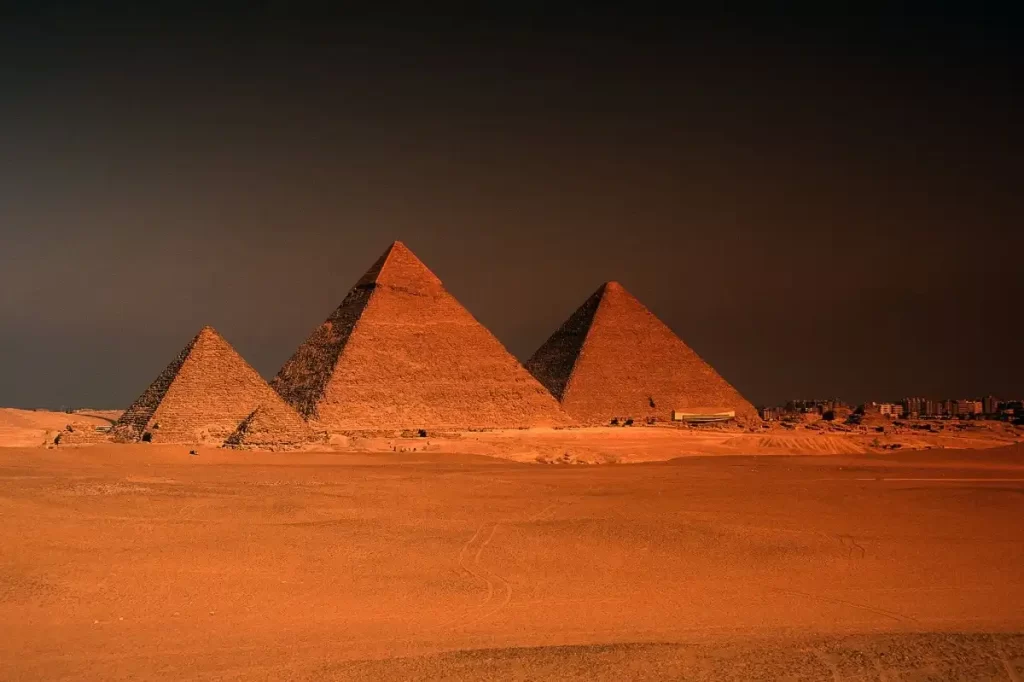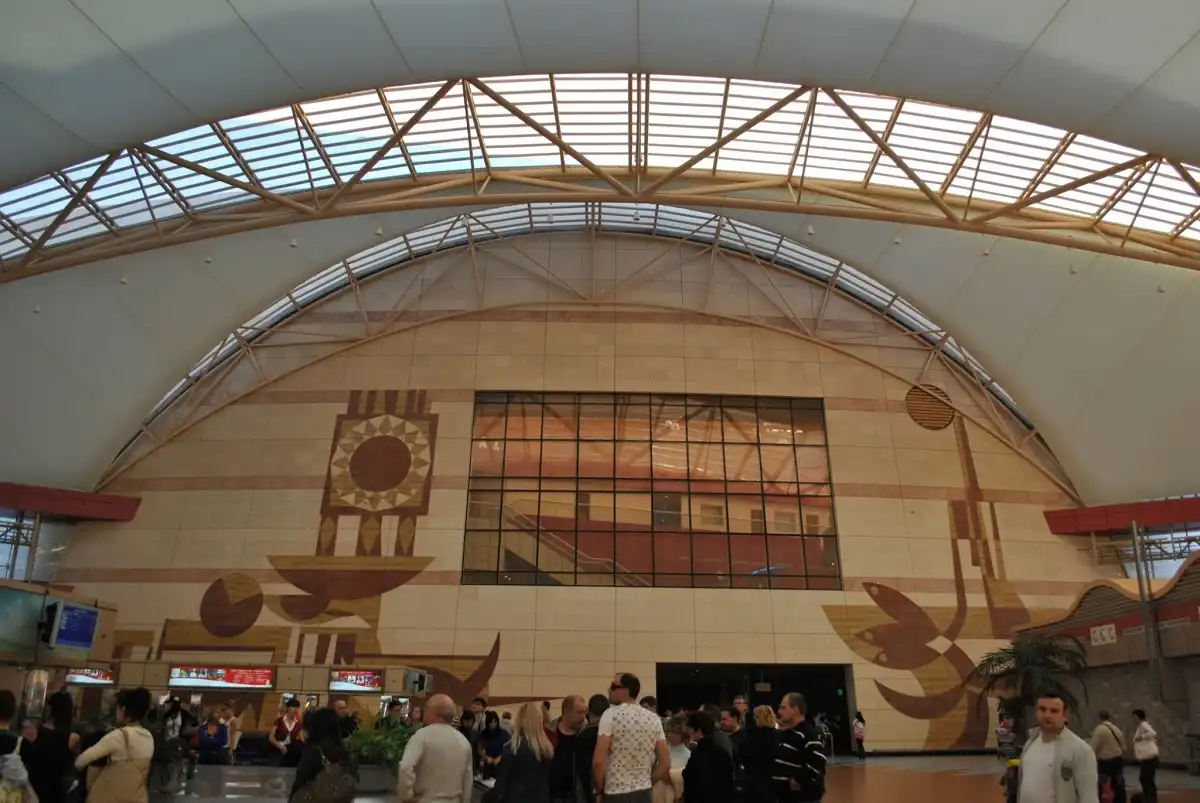
Giza Pyramids Complex
[ez-toc]
Overview of the Giza Pyramids Complex
The complex of the Giza Pyramids serves as a metaphor for the pinnacle of human ingenuity and tenacity. The major goal of this site is to provide all available information and facts regarding the magnificent Giza pyramid complex. This post was created by a team of seasoned tour operators, tour guides, and travel advisors that are very informed, competent, and skilled. The Magnificent Giza Pyramids Complex is the only monument on earth that can truly capture the meaning of the word splendor. The pyramids were preserved by the ancient Pharaohs as a mystical staircase to the sky where they could take their proper place next to the gods.
The complex includes the great pyramid of Giza, the last surviving example of one of the seven wonders of the ancient world, along with two additional pyramids, each of which is impressive in its own right and symbolizes the level of political and economic stability as well as unimaginable knowledge and skill in the field of architecture and construction. The complex took on significant significance as a representation of ancient Egypt’s culture, showing all the characteristics that made this region the driving force behind advancements in all spheres of human endeavor. Ancient Egyptian monarchs are believed to have been buried in heaven in the Giza Necropolis. The Sphinx is home to the three major Giza pyramid complexes, as well as the noble worker’s hamlet, which includes a number of modest industrial complexes and a number of graves. The town pyramids, several causeways, and smaller “queen pyramids” are all contained within the complex.
History
The complex, which dates back over 4,000 years to Egypt’s old kingdom (2686–2181 BC) and the 4th dynasty (2613–2493 BC), is one of the last archaic structures still standing on Earth. It continues to captivate anybody who sees it. It has three enormous pyramids built by Khufu, Khafra, and Menkaure who wanted to preserve their names and history throughout the ages. To serve as his final resting place and aid in his soul’s ascent to the skies, each pharaoh constructed a pyramid. The valley temple, where the kings and queens were mummified and prepared to go to the other side, is located next to the pyramids.
Location
The complex is situated in the western desert 9 kilometers (5 miles) west of the Nile River, 13 kilometers (8 miles) southwest of Cairo’s downtown, and not far from Memphis, a renowned city.
The Purpose of the Giza Pyramids Complex
The primary goal of building the Giza pyramid complex was to preserve and safeguard the ancient pharaohs’ mummies so that their “Ka” spirit, which remained with the corpse, may later return to the body once more, fully transform, and ascend to the afterlife. Ancient Egyptians, particularly the monarchs, thought that dying was a necessary step on the way to the afterlife, also referred to as the “fields of reeds.” The Pharaoh’s body and spirit were protected by the pyramid so that he may succeed as the next monarch of the dead. All the goods required for the afterlife were kept in the Giza Pyramids.
Layout
The three major pyramids of Giza are located in the 16,203.36 ha (62,5615 sq mi) Giza Pyramids Complex Necropolis, each of which has a smaller complex containing their wives and children. The complex is renowned for hosting the Great Sphinx, Egypt’s lone divine protector, on its eastern side. Many academics think that the Orion constellation correlation theory can be used to explain the placement and design of the Pyramids. The queen’s pyramids, valley pyramids, and causeways are a few of the smaller satellite structures that exist alongside the pyramids. The three pyramids’ damaged interiors and exteriors, stolen valuables, and unaccounted-for mummies are all the result of robbery and tomb raiding, which explains why. The Giza Pyramids are surrounded by a large stone wall that housed the pyramid workers which became known as the worker’s village and dates across the middle 4th dynasty (2520 – 2472 BC).
Construction
The belief that the pyramids were created by moving enormous stones from a quarry and dragging and hoisting them into the area that hosts the Giza complex is the basis for the majority of responses to the very significant and intricate subject of how the pyramids were built. The Giza pyramids were built in horizontal layers with each 2.5-ton limestone block atop the other in a perfectly symmetrical and balanced manner, to the extent that all three of the pyramids were astronomically oriented to the east-west and north-south within a small fraction of a degree, as described in more detail in the book The Great Pyramids of Giza. As a result, more than 4500 years later, the Giza pyramid complex is still standing and draws tourists from around the world.
The Great Pyramid of King Khufu
The Great Pyramid, which took 20 years to construct for King Khufu in the old kingdom between 2580 BC and 2560 BC, is the final surviving example of an ancient wonder. The Greek word Cheops is another name for it. It rose to 147 meters (481 feet) in height and held the title for more than 3,800 years when the Lincoln Cathedral was built in 1311. It was constructed with 2.3 million limestone stones, each weighing 2.5 tons, totaling 57.5 million tons, along with 100,000 unpaid laborers who worked in shifts. Its sides rise at an angle of 51°52′ and are precisely aligned with the compass’s four cardinal directions.
It was erected by Hemiunu, the vizier of King Khufu, who made use of all the resources available during the heyday of the old kingdom to produce a magnificent masterpiece of amazing buildings. The King’s chamber, which is made entirely of granite, the Queen’s chamber, and the Grand gallery make up the pyramid’s interior design, which is its most fascinating feature. King Khfuf’s solar boat was delivered from the site to the Grand Egyptian Museum.
Pyramid of King Khafra
King Khafra (2558-2532 BC) of Egypt’s 4th dynasty constructed the country’s second-largest pyramid in 2540 BC. Khafre, who is Khufu’s son, wanted to build a building that looked like his father’s. The Greek name Chephren is used to refer to the pyramid. It is likewise composed of limestone, with an angle of 51°50’24, and rises to a height of 136.4 (448 ft) from a base of 215.5 m (706 ft). Due to its elevated position and the steeper angle of inclination, Khafre’s pyramid is known to appear larger than Khufu’s pyramids. The summit of the pyramid is also a bit unique as it is able to retain a majestic display of casing stones. In front of the pyramid is the sphinx statue in the west which resembles a mythical creature with the body of a lion and the head of King Khafre measuring 73 m (240 ft) long from paw to tail, 19 m (62 ft) wide and 20 m (66 ft) high from the base to the top of the head.
Pyramids of King Menkaure
The smallest of the three pyramids was constructed in 2510 BC as the tomb of King Menkaure, the sixth ruler of the 4th dynasty. It has an exterior made of limestone and an interior made of red granite, and it has a height of 61 meters (204 feet) with an incline angle of 51 degrees twenty-five inches. Red granite makes up the pyramid’s interior.
The Sphinx
The Great Sphinx, which was constructed during the rule of Pharaoh Khafre in the 4th dynasty (2558–2532 BC), is a living miracle and a significant historical and cultural asset. Hor-em-Akhet, which translates to “Horus of the Horizon,” was its name. It was carved from a massive limestone rock into the shape of a mythical creature known as the sphinx has the body of a lion and the head of a man, probably king Khafre himself to display his wisdom and power, it is famous for being the oldest and largest monolith statue on earth. It measures 73 meters (240 feet) in length, 19 meters (62 feet), and 20 meters in height (66 ft). Numerous questions and riddles have surrounded the many facets of the sphinx, including how old the sphinx actually is, what the original design was, and what the sphinx’s true function was.
The Worker’s village
More than 10,000 quarry workers, metalworkers, architects, carpenters, haulers, and masons lived in the Worker’s village, a crucial area from the middle of the 4th Dynasty (2520-2472 BC), where they worked for more than 30 years to build the magnificent pyramids of Giza. It is situated 500 meters west of the metropolis of Giza. They had three-month shifts, and this was where they were based. Numerous tombs belonging to the majority of the workers who built the pyramids may be found there, serving as proof that they were all unpaid civil servants who were also fed and treated properly.
The community, which is located southeast of the Khafre and Menkaure complexes, lacks communal sleeping quarters, breweries, bakeries, and kitchens, as well as a hospital and a cemetery. Their major sources of food were bread, beef, and fish. Numerous tomb paintings from the worker’s village and the Giza pyramids show scenes from daily life in ancient Egypt, including farmers working in their fields, caring for animals, fishing, and hunting, as well as scenes from carpentry, metalworking, religious rituals, and funeral customs.



